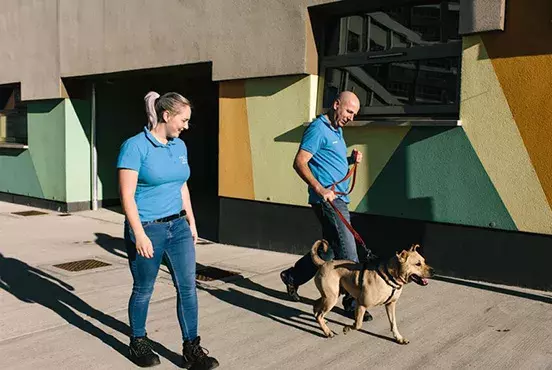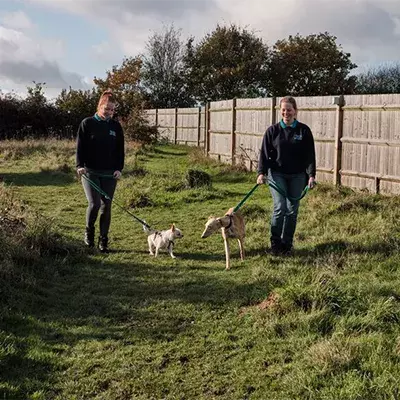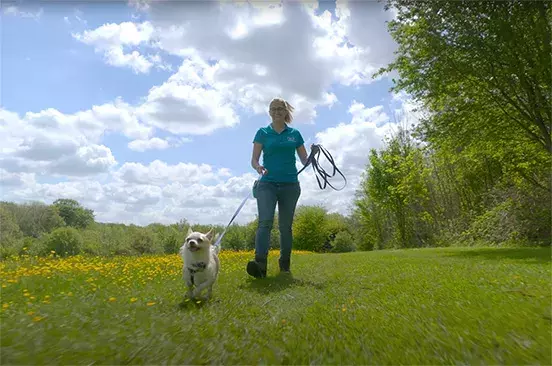It’s a good idea to introduce these items early-on so that when it comes to walking nicely on the lead, for example, your dog is already comfortable with the collar, harness and lead and associates them with good things.

Before you start this process it’s important to understand whether or not your dog is comfortable being handled. If your dog is uncomfortable, they will show signs such as looking at your hand, shifting around when touched, going stiff, mouthing or snapping. If you notice any of this, check out our video on how to get your dog used to being handled, or if the behaviour escalates or your dog seems very stressed, we recommend getting in touch with a qualified behaviourist for help.
Watch our video on getting your dog used to wearing a collar, lead, and/or harness, or follow along with the steps below:
GET YOUR DOG USED TO WEARING A COLLAR
While we might think collars are part and parcel of owning a dog, they don’t always feel natural to our pets. It’s important they learn to enjoy and be relaxed around them as they will be a big part of their daily lives, and help us keep them safe and secure.
STEP 1
Grab some treats and the collar somewhere where your dog feels comfortable. Make the collar a big, loose size and hold it in one hand. Hold some treats in your other hand and place it through the collar. Using the treats, lure your dog through the collar. When they put their head through the collar say “Yes” and reward them with the treats. If your dog cannot put its entire head through the collar straight away, reward them as they move closer, five attempts at a time, until they’re happy putting their head through.
STEP 2
Once your dog is happy for the collar to be placed over their head, you can begin to move your fingers around at the back of the collar as if you were clipping it up. Undo the collar, then practise placing it around your dog’s neck. Moving the straps as if you were doing it up, but don’t actually fix it, then reward. Continue this until your dog is comfortable.
STEP 3
Once your dog is comfortable, you can clip the collar on the correct setting you need for them. Make sure it’s not too tight, or too loose. You should be able to fit two fingers between their neck and the collar, no more. Praise your dog when they have it on, and give them a reward. Remove the collar after 5 seconds and gradually build up the duration of wearing it from seconds, to minutes then hours. You can reinforce their positive association with the collar by having them wear it during playtime and when you’re giving them attention so they can get used to wearing it whilst doing other normal daily activities.
GET YOUR DOG USED TO WEARING A HARNESS
There are different types of harness to suit every dog and owner, but the most important things is that it fits your dog, and doesn’t cause them any pain or discomfort. Always make sure to look at the instructions and recommendations for your chosen harness or ask how it should be fitted when purchasing.
STEP 1
The first couple of steps are similar to getting your dog used to a collar; you want your dog to not be worried of the harness and to associate the harness with good things.
Hold the top of the harness in one hand and using treats in your other hand, lure your dog inside and through, rewarding for any progress they make if they’re hesitant. Build up gradually until your dog is happy for you to place the harness around their neck. Once you can have the harness around their neck, reward them with treats and praise, then remove the harness. Build up the duration they’re wearing the harness from seconds to minutes slowly, five attempts at a time.
If your dog shows signs of being uncomfortable such as pawing, scratching, mouthing or moving away you can use some mental stimulation to distract them. You can find out more about this in our brain games for dogs video.
Remember only take the harness off when it has been positive and not when they have started to try and remove it, as you will be reinforcing this behaviour and not the intended one. Wait till they are distracted by some mental stimulation and then calmly remove it.
STEP 2
Once your dog is comfortable with wearing the harness around their neck, you want to get them used to the rest of the harness and putting it on fully. You should always make sure you’re not leaning over your dog to do this, instead, kneel down or get down to a comfortable level next to them, and have your body on the same side that you’re clipping up.
STEP 3
Similar to the collar, you need to get your dog used to having the harness straps moved around their back and under their chest. With the harness around their neck, gently move the straps around without clipping them together, and then reward with a treat; start with one second of movement and build up to 30 seconds. Once they are comfortable and used to this, remove the harness.
STEP 4
Some dogs can be scared of the noise the harness makes when it clips together, so we want to make sure your dog is comfortable with the sound before we do the straps up on their body. To do this, hold the harness in front of your dog, clip one of the straps together and give them treat. This helps the dog get used to the noise and associate it with positive things.
STEP 5
Now, carry out the process of putting the harness on, then clip the harness up at the back and reward. Calmly praise your dog, reward them with a treat and then remove. Build up the duration of them wearing the clipped-up harness from seconds, to minutes, to an hour. During this time, you can show them they can still do everyday fun activities while wearing the harness and reinforce the positive association using playtime, fuss and attention and other mental stimulation games.
GET YOUR DOG USED TO USING A LEAD
Some dogs will react in different ways to being put on a lead. Some will be fine, but others might put the brakes on and not move, or they might bite or rag and pull on the lead. If this happens, the key is to go back to basics and give them positive associations with what happens when the lead goes on.
STEP 1
Either at home, or in the garden, clip the lead to your dog, calmly drop it, and reward them. Then, with the lead still attached, sprinkle treats around the room or space for them to follow and pick up. You can also attach the lead before mealtimes and remove it once they’re finished so they get used to the lead being associated with positive things like eating.
STEP 2
Next, we want to get your dog used to you being at the other end of the lead. Clip the lead on and sprinkle treats around the floor again, but this time hold the lead loosely in your hand and calmly follow your dog as they follow the trail.
You could also try it when they are distracted with other things. When your dog is showing signs they need to go to the toilet for example, clip the lead on, and with no pressure on the lead calmly follow them around the garden at a slight distance.
STEP 3
Now it’s time to get your dog used to some gentle pressure on the lead. Ask your dog to sit, then apply slight pressure on the lead for a second, release, praise them and reward them, slowly increasing the duration each time. You’re not pulling or yanking on the lead, think of it more as gently leaning away from your dog.
This technique can also be good for reinforcing your dog’s recall behaviour. Attach the lead, move away from your dog and apply light pressure to the lead. As you apply the light pressure call them over to you and reward when they get to you.
You can practise on the lead anywhere in the garden or home, and it doesn’t have to be for long durations. Even having your dog walk with you from room to room for a minute can really help get them used to the lead being attached and feel comfortable with pressure. Keep praising them and rewarding as you go. Slowly build up to walking on the lead outside the house, to make sure they’re comfortable with it. This will also help them pick up good habits, which should mean they are more likely to walk calmly on the lead.



